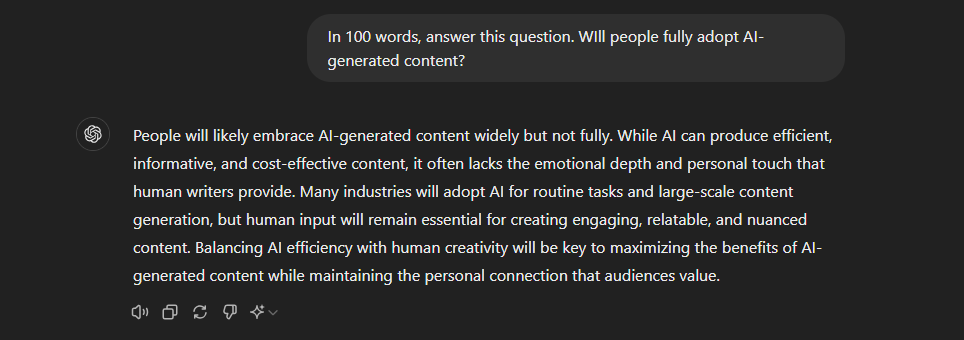In today's digital age, artificial intelligence (AI) plays a major role in content creation.
However, AI-generated content often lacks the human touch, making it feel robotic and impersonal. This can be a problem if you want to connect with your audience on a deeper level. To bridge this gap, you need to humanize your AI content.
In this guide, we explain how to do just that using humanizer tools. We'll explore various methods and tools that add a personal touch to AI content, making it more engaging and relatable.
Whether you're a blogger, marketer, or business owner, this guide will help you create content that resonates with your readers.
What is AI-generated Content?
AI-generated content is text, images, or videos created by artificial intelligence software. These AI tools use algorithms and data to produce content that looks like it was made by a person.
For example, AI can write articles, create social media posts, and even generate art or music. Here's an example of AI-generated text:

And here's an example of an AI-generated image:

Popular AI content creation tools include GPT (like the one used to write this text), which can generate text, DALL-E, which creates images based on text descriptions, and Claude, Jasper, Bard and other popular AI tools used for content creation.
How do AI Generate Content?
AI-generated content works by analyzing vast amounts of data and learning patterns from it. When asked to create something, the AI uses what it has learned to produce new content.
For instance, if you need a blog post about travel tips, you can input a few keywords into the AI tool, and it will generate a coherent article on the topic.
Companies often use AI-generated content to save time and resources. For example, a news website might use AI to write short news summaries, or a fashion brand could use AI to create product descriptions.
However, AI lacks human touch. That's where 'humanizing' AI content comes in. By adding your own creativity and understanding of emotions, you can take AI-generated text and turn it into something truly engaging for your readers.
The future of AI-generated content is likely to involve a combination of AI and human input, with AI handling the bulk of the content creation and humans adding the final touches to make it more relatable and engaging.
Furthermore, the future of AI-generated Content will likely involve a combination of AI and human input, with AI handling the bulk of the content creation and humans adding the final touches to make it more relatable and engaging.
Why Do you Need to Humanize AI-generated Content?
Humanizing AI content is not just a trend, it's a necessity. It's a way to make your content more engaging, relatable, and trustworthy for your audience.
While AI can create content quickly and efficiently, it often lacks the personal touch that makes readers feel connected. By humanizing your AI content, you're not just improving its quality, you're also enhancing your relationship with your audience.
Here are a few reasons why humanizing AI content is important:
1. Builds Trust:
People are more likely to trust content that feels authentic and relatable. For example, a product review written by an AI might be informative, but it can come across as impersonal. Adding a human touch, like first name, personal experiences, or anecdotes, makes the review more credible and trustworthy.
2. Engages Readers:
Humanized content is not just about adding a personal touch, it's about enhancing your audience's experience. AI-generated content can sometimes feel monotonous or overly factual.
By injecting personality, humor, or emotion, you're not just making the content more interesting, you're also making it more enjoyable for your audience.
For instance, a travel blog with personal stories and vivid descriptions will resonate more with readers than a plain list of travel tips that might sound robotic.
3. Improves Readability:
Humanized content is often easier to read and understand. AI might generate complex sentences or use jargon that can confuse readers. Simplifying the language and adding a conversational tone can make the content more accessible.
If you use GPT tools well, you will have encountered phrases like 'in the realm, a cacophony of ideas, revolutionize your taste' and other popular ones that complicate sentences.
For example, explaining a technical concept in simple terms with relatable examples helps readers grasp the information better than prolonging the meanings of paragraphs with heavy words.
4. Enhances Connection:
People connect with content that reflects real human experiences and emotions. Whether it's a heartfelt story or a shared opinion, humanized content creates a bond between the writer and the audience.
This connection can lead to a variety of benefits, such as increased engagement, higher trust, and more loyal readers. By humanizing your AI content, you can tap into these benefits and create content that genuinely resonates with your audience.
For instance, a company's AI-generated customer service emails can feel cold and distant. Adding a friendly greeting, expressing empathy, or including a personalized sign-off can make the interaction feel more human.
What are the Steps to Humanize AI-generated Content?
Step 1: Understand the Basics of Your AI Tool
Before you start humanizing your AI-generated content, it's crucial to understand how your AI tool works. Tools like GPT-4 (which powers many AI writing assistants) generate content based on patterns and data on which they've been trained.
They can produce coherent and informative text, but often lack the nuances of human expression.
For instance, AI tools might struggle with understanding sarcasm, humor, or cultural references. You need to familiarize yourself with the strengths and weaknesses of your chosen AI tool to better identify areas that need humanizing.
For example, how GPT works differs a bit from Claude, Gemini, and other tools.
Step 2: Define Your Audience and Tone
Humanizing Content is a collaborative process that begins with understanding your audience. You need to determine who you are writing for and what tone will best connect with them. Your audience's preferences and needs should guide your content creation process.
For example, a blog for young parents might benefit from a warm and friendly tone, while a report for business executives might need a more formal and professional approach. Defining this early will guide your editing process.
Step 3: Use Humanizer Tools for Initial Tweaks
Several tools can help you add a human touch to AI-generated content. These are often referred to as 'humanizer tools '. They are designed to enhance the human elements in AI-generated content, such as tone, style, and readability. Here are a few examples of humanizer tools: [Insert examples of humanizer tools].
Here are a few:
- Hemingway Editor: This tool helps simplify complex sentences, making your content more readable. It highlights hard-to-read sentences and suggests simpler alternatives, promoting a conversational tone.
- Grammarly: Beyond grammar checks, Grammarly offers style suggestions to make your content more engaging. It can help adjust the tone and improve clarity.
- QuillBot: QuillBot can rephrase sentences to make them sound more natural. It's helpful in transforming stiff or overly formal AI-generated text into smoother, more human-sounding prose.
Step 4: Inject Personal Experiences and Anecdotes
Adding personal stories or anecdotes can significantly humanize content. AI lacks personal experiences, so this is where your input becomes crucial.
For example, if you're writing a travel blog, include a personal story about your favorite destination. Describe the sights, sounds, and emotions you experienced. This adds depth and relatability to your content.
Example:
- AI-generated text: "Paris is a beautiful city with many tourist attractions."
- Humanized text: "I'll never forget my first visit to Paris. Strolling down the charming streets of Montmartre, with the aroma of freshly baked croissants in the air, was like stepping into a dream."
Step 5: Use Emotive Language
AI-generated content can often be factual but emotionally flat. Incorporating emotive language helps convey feelings and engage readers on an emotional level. Words that evoke emotions like "thrilled," "heartwarming," "challenging," or "inspiring" can make a big difference.
Example:
- AI-generated text: "The project was completed successfully."
- Humanized text: "We were thrilled when the project was completed successfully, overcoming numerous challenges along the way."
Step 6: Add Questions and Call-to-Actions
Asking questions and including calls-to-action (CTAs) can make the content feel more interactive and engaging. It encourages readers to think, respond, or take action, fostering a sense of conversation rather than a one-sided information dump.
Example:
- AI-generated text: "Regular exercise is beneficial for health."
- Humanized text: "Have you ever noticed how much better you feel after a good workout? Regular exercise isn't just beneficial for health; it's a fantastic mood booster too! Why not start your fitness journey today?"
Step 7: Include Humor and Playful Elements
Humor can lighten the tone and make your content more enjoyable. While AI can generate humor to some extent, it often needs to catch up on cultural nuances and timing. Adding a touch of humor yourself can make your content more relatable and fun.
Example:
- AI-generated text: "Maintaining a balanced diet is important."
- Humanized text: "Sure, we all love a good slice of pizza now and then, but maintaining a balanced diet is what keeps us going in the long run. Who says you can't have much fun with your food choices?"
Step 8: Utilize Feedback Loops
Once you've made initial changes, gather feedback from real people. Share your content with colleagues, friends, or a focus group to get their insights on what feels authentic and what doesn't. Use their feedback to make further adjustments.
Step 9: Keep Up with Trends and Cultural References
Stay updated with current trends and cultural references to make your content relevant and timely. This helps your writing resonate with readers who are familiar with those trends. However, be cautious and ensure your references are appropriate for your audience.
Example:
- AI-generated text: "Virtual reality is becoming more popular."
- Humanized text: "Virtual reality is taking off faster than a rocket ship in a sci-fi movie. Have you tried exploring a virtual world yet?"
Step 10: Review and Refine
Finally, review your Content multiple times. Each read-through can reveal areas that still feel a bit robotic or need a touch more humanization. Refinement is key to ensuring your content feels genuine and engaging.
We often share content generated with other team members to vet and call attention to any robotic message or errors, which usually come out well.
Example
Let's look at a complete example transformation:
- AI-generated text: "Remote work has increased in popularity. Many companies now allow employees to work from home. This has led to higher productivity and job satisfaction."
- Humanized text: "Remember when working from home felt like a dream come true? Now, it's a reality for many of us. With more companies embracing remote work, employees are finding that they can be more productive and happier without the daily commute. Have you noticed how much your work-life balance has improved?"
Conclusion
Humanizing AI-generated Content is an ongoing process that involves adding personal touches, emotional depth, and interactive elements. Tools like Hemingway Editor, Grammarly, and QuillBot can help you make initial tweaks to improve readability and tone.
Injecting personal experiences, using emotive language, adding questions and CTAs, incorporating humor, and staying updated with trends are all effective strategies. Gathering feedback and continuously refining your content will ensure it resonates well with your audience.
The goal is to blend the efficiency of AI with the authenticity of human expression, creating content that is both informative and deeply engaging for all.